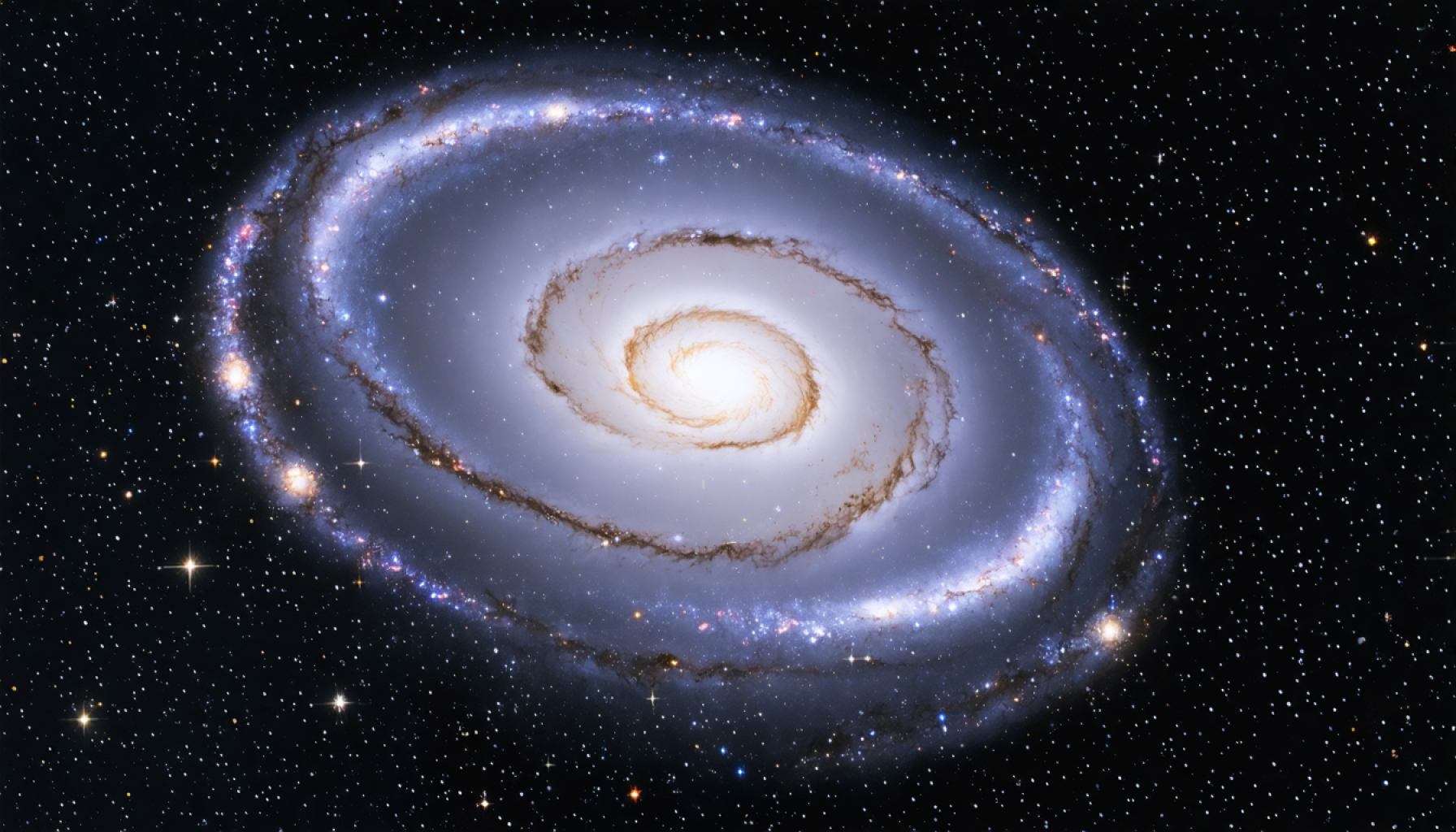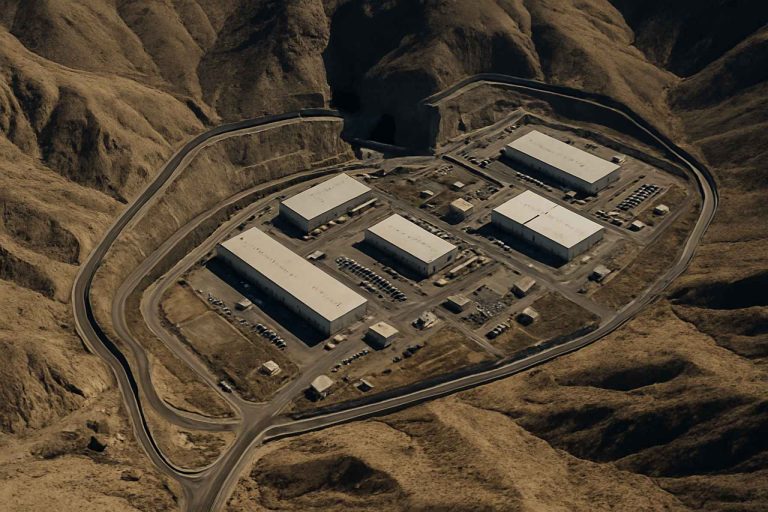
- The Big Wheel, a massive spiral galaxy, was discovered by the James Webb Space Telescope.
- This galaxy, five times larger than the Milky Way, formed just two billion years after the Big Bang.
- The discovery challenges previous cosmic timelines, suggesting large galaxies formed earlier than thought.
- Its vast arms, spanning 100,000 light-years, offer insights into early universe conditions.
- This galaxy offers clues about the rapid assembly of colossal cosmic structures in the universe’s infancy.
- Researchers stress the importance of studying ancient galactic environments for understanding galaxy evolution.
- The Big Wheel’s secrets could reveal more about the universe’s formation and longstanding mysteries.
Astronomy’s gaze deep into the cosmos recently unveiled a startling wonder—a massive spiral galaxy, whimsically dubbed the “Big Wheel.” Emerging from the depths of the universe, this galactic giant appears as a whisper from the cosmos’ nascent days, a colossal marvel that emerged just two billion years after the Big Bang. Unveiled thanks to the piercing eyes of the James Webb Space Telescope, the Big Wheel stands as a beacon of both mystery and revelation.
Picture a galaxy five times heftier than our beloved Milky Way, spanning an awe-inspiring expanse twice as wide. Its sheer magnitude challenges our understanding, capturing the imagination of astronomers who liken the discovery to stumbling upon a living dinosaur roaming the Earth today. The Big Wheel’s existence rewrites the cosmic timeline, suggesting that such intricate, sprawling formations arose much earlier than previously conceived.
The galaxy’s colossal arms, stretching a hundred thousand light-years across, whisper tales from an era when the universe was an untamed wilderness. Unlike any known galaxies cataloged from that epoch, this specter from the past defies expectations. Before its discovery, the common thought was that early disk-shaped galaxies—ancestors of spirals—were diminutive, tentative structures, mere foreshadowings of the grand cosmic wheels to come.
Standing at the forefront of this discovery, experts like Charles Steidel from Caltech unveil the narrative of a universe that was rapidly assembling colossal cosmic structures. Yet, the Big Wheel holds additional secrets. Scientists propose that over eons, it likely lost its gaseous contents, dispersed by the inexorable pull of cosmic forces, leading to the skeletal remains we attempt to map today.
The findings also underscore the uncharted richness of ancient galactic environments. Sebastiano Cantalupo from the University of Milano-Bicocca emphasizes the need for a thorough exploration of these primordial arenas. Learning the intricacies of early cosmic environments could unravel the mysteries of galaxy formation and evolution, offering fresh insights into the universe’s formative years.
Through the remarkable lens of modern astronomy, the Big Wheel not only expands our understanding but also kindles our imagination. It reminds us that the universe, in its boundless complexity, often dances to the tune of its mysteries long after the music has faded. As astronomers peer deeper into the inky fabric of space, they reveal celestial masterpieces that tell us, unequivocally, that the story of the universe is far from written.
A Colossal Discovery: The “Big Wheel” Galaxy Unveils New Cosmic Mysteries
Unveiling the “Big Wheel” Galaxy
The recent discovery of a massive spiral galaxy, aptly named the “Big Wheel,” has taken the astronomical community by storm. Detected by the James Webb Space Telescope, this galaxy presents a unique opportunity to reassess our understanding of early cosmic structures. Located at a point in the universe just two billion years after the Big Bang, the Big Wheel challenges preconceived notions about galaxy formation in the infant stages of the cosmos.
Intriguing Facts about the Big Wheel Galaxy
1. Size and Structure: The Big Wheel is astonishingly five times the mass of the Milky Way and spans twice its width, making it one of the most impressive galactic formations ever discovered from such an early time.
2. Historical Significance: This galaxy offers a glimpse into an era when the universe was a dynamic and chaotic environment. It suggests that large, complex galactic structures could form far earlier than previously thought.
3. Comparison with Known Galaxies: Unlike the smaller, primitive disk-shaped galaxies that were expected to populate the early universe, the Big Wheel’s complexity indicates that advanced spiral formations emerged relatively quickly.
4. Evolutionary Theories: Experts suggest that as the Big Wheel evolved over billions of years, it may have lost much of its gaseous material due to gravitational interactions, leaving the structure that we observe today.
The James Webb Space Telescope: A Game Changer
The role of the James Webb Space Telescope in this discovery cannot be understated. Its advanced infrared capabilities allow scientists to peer into the earliest epochs of the universe, revealing previously unseen galaxies and star formations. This capability is crucial for understanding the process of galaxy formation during the early universe.
How-To Steps for Aspiring Astronomers
1. Get Familiar with Celestial Phenomena: Understanding the fundamental concepts of astronomy, such as types of galaxies and cosmic events, is essential.
2. Use Advanced Tools: Gain experience with telescopes and data analysis software used in astronomical research.
3. Stay Updated on New Discoveries: Regularly follow reputed journals and publications in astronomy to keep abreast of new findings and theories.
Real-World Use Cases
Understanding early galaxy formation has several implications:
– Astrophysics Models: It provides critical data for refining models of cosmic evolution.
– Predictive Analysis: Offers insights into predicting other similar cosmic structures.
– Educational Value: Expands educational content in astronomy, offering more in-depth study of the universe’s infancy.
Market Forecasts & Industry Trends
The discovery underscores the increasing reliance on powerful telescopic technologies like the James Webb Space Telescope. As the demand for more advanced astronomical tools grows, industries related to optics and space exploration are likely to see substantial investment and innovation.
Insights & Predictions
– The study of early galaxies like the Big Wheel will likely lead to new theories about the rate of star and galaxy formation in the early universe.
– As more discoveries are made, the timeline of galaxy evolution will be continually adjusted to reflect these new insights.
Quick Tips
– Always verify astrophysical data and findings through credible sources and peer-reviewed research.
– Engage with online forums and communities to discuss discoveries and share information with fellow enthusiasts.
For more information on groundbreaking astronomical discoveries, you can visit NASA’s official site.
This groundbreaking discovery of the Big Wheel galaxy not only enhances our cosmic knowledge but also opens new avenues of exploration in astronomy, reminding us of the boundless mysteries awaiting us in the universe.



